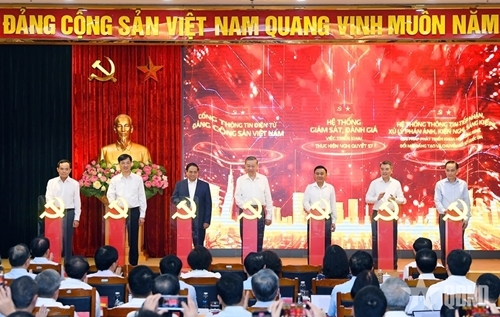The Party chief made the call while chairing a meeting of the Central Steering Committee for the Development of Science, Technology, Innovation, and Digital Transformation in Hanoi on July 2 to review its performance in the first haft of 2025 and set tasks for the rest of the year.
At the meeting, the steering committee reported that implementing Resolution No.57-NQ/TW over the past six months has sparked major shifts in awareness and action throughout the political system. The National Assembly passed two foundational laws — the Law on Science, Technology and Innovation, and the Law on the Digital Technology Industry — establishing a legal basis for developing high-impact sectors such as artificial intelligence, semiconductors, and big data.
    |
 |
|
From left: Prime Minister Pham Minh Chinh, Party General Secretary To Lam and permanent member of the Party Central Committee's Secretariat Tran Cam Tu launch three digital platforms which are vital to Resolution 57’s performance. |
To support this transition, the Government issued 16 decrees and one resolution, introducing key reforms on administrative procedures, single-window mechanisms, and decentralized governance aligned with the newly-adopted two-tier local administration model.
A major breakthrough was the steering committee’s simultaneous rollout of two overarching frameworks and the deployment of two integrated systems - one for monitoring the implementation of Resolution 57 and another for gathering and processing public feedback, initiatives, and scientific solutions. These tools are helping lay the foundation for a real-time, data-driven governance model.
The Government also identified 11 key strategic technology groups essential for sustainable growth and global competitiveness. Vietnam’s science and innovation ecosystem continued to expand, with 858 science and technology firms, 45 high-tech enterprises, and over 73,000 digital tech companies operating. The Ministry of Science and Technology mobilized 277 experts to support major AI initiatives, boosting high-level human resources in strategic sectors.
Domestic tech firms showed strong engagement — a testament that Resolution 57 has become a broad-based societal and business movement, not merely a government-led initiative.
However, the steering committee also pointed to challenges, including fragmented policy frameworks, disjointed national data infrastructure, limited data sharing, and a shortage of skilled workforce.
General Secretary Lam showed delight at the achievements. For the rest of 2025, he stressed that digital transformation must become the “central nervous system” — the bridge between provincial and local administrations — and act as a “data brain” to synthesize, analyze, and provide early warnings. Without it, the new two-tier administration model cannot function effectively, he underlined.
The Party chief stressed the need for an extensive communications campaign on the groundbreaking aspects of the Law on Science, Technology and Innovation, along with the preparations of sub-law legal documents as well as sector-specific regulations, and the effective, substantive rollout of fully online public services.
Localities and agencies must incorporate the strategic action plan and its implementation guidance into their own programs, aligned with existing strategic systems and key national initiatives, he said.
A new data governance approach is essential, prioritizing efficiency and ensuring data is accurate, clean, real-time, and interconnected, the Party leader said, adding ministries must urgently complete and operationalize the National Data Centre.
Administrative processes must be restructured to enable seamless data sharing and improve digital services for people and businesses. National 5G deployment must be accelerated, alongside satellite internet, electricity stability, and closing coverage gaps in remote regions, the Party leader requested.
Grassroots infrastructure must be reinforced with reliable networks, endpoint devices, and sufficient personnel to support digital transformation, he noted.
General Secretary Lam also emphasized the need to immediately issue policies to attract and retain high-level domestic and overseas talents, particularly in critical fields like AI, semiconductors, and advanced materials. This effort will be anchored in a National Talent Strategy through 2030, with a vision to 2050.
Funding should focus on flagship, interdisciplinary, and interregional projects with real impacts, avoiding fragmented, symbolic spending. Priority will be given to digital initiatives serving the new administration model and to the most critical projects outlined in the Strategic Action Plan.
He further underlined the need to safeguard data security, privacy, and intellectual property.
At the conference, General Secretary Lam and other senior Party and State leaders officially launched three digital platforms vital to Resolution 57’s performance, including the Communist Party of Vietnam’s online portal; the monitoring and evaluation system for the implementation of Resolution 57; and the national system for receiving feedback, proposals, initiatives, and solutions on the development of science, technology, innovation, and digital transformation.
Source: VNA